Ingredients You Need in Your Skin Care Routine
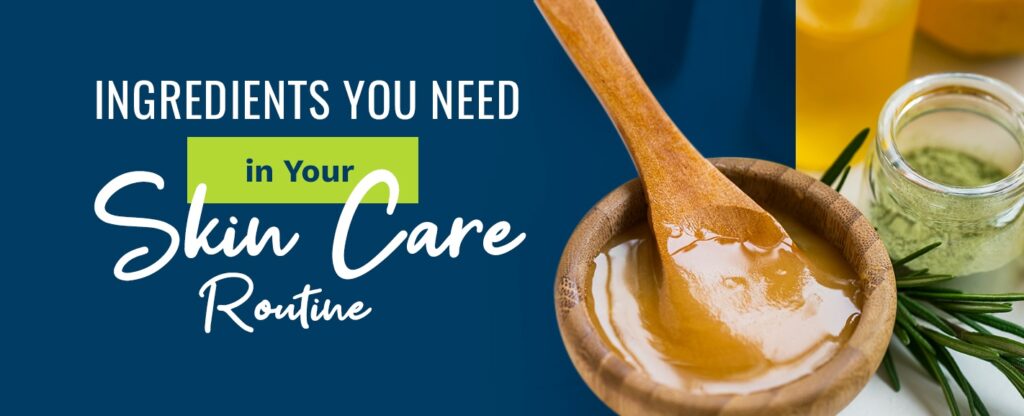
While some beauty trends may come and go, there’s one thing that will never go out of style — taking care of your skin. Part of taking good care of your skin is figuring out which ingredients provide the most benefits to it and which ones aren’t so great for your skin’s health. The ingredients that will work best for you depend in large part on the type of skin you have. If you have dry skin, you’ll want to choose products that are different from the ones a person with oily skin might use. If you have sensitive skin, you want to avoid products that contain potentially irritating ingredients.
Learn more about what to look for when choosing skin care products and the benefits of starting a skin care routine today.

Benefits of a Skin Care Routine
Your skin is the largest organ in your body. It helps to protect you from infection and injury. One way to say thanks to your skin for all that it does is by taking good care of it.
Perhaps the most significant benefit of having a skin care routine is protecting your skin. Your skin has three layers — the epidermis (outer layer), the dermis (middle layer) and the subcutis (the deepest layer). The epidermis, the outer layer, is the protective layer of your skin. Each day, it’s exposed to ultraviolet light, free radicals, dirt and pollutants, all of which can contribute to signs of aging, skin irritation and in some cases, cancer.
Developing a skin care routine that offers protection against ultraviolet rays, cleanses the skin and hydrates and moisturizes it will help to keep your skin looking great and functioning at its best for years to come.
Your skin care routine can also help you feel more confident and better about yourself. Your skin care routine can help you feel grounded and relaxed. Taking care of yourself and your skin shows that you’re making yourself a priority and can improve the relationship you have with yourself.
What Ingredients Are Good for Dry Skin?
Do you suffer from dry, flaky skin and need relief? While some people may suffer from dry skin only during winter, others might have chronically dry skin. Harsh soap, cold air or bathing in hot water can contribute to dry skin.
Moisturizers alleviate dry skin by rehydrating the top layer of your skin cells and sealing in moisture to help the skin can stay soft. You’ll find three primary ingredients in most moisturizers — humectants, which attract moisture, occlusives, which seal the moisture and emollients, which contain water, oil and an emulsifier. Three of the best skin care ingredients for dry skin to look for are:
1. Hyaluronic Acid
Hyaluronic acid (HA), actually occurs naturally in the body in your joints, eyes and skin. When applied to the surface of the skin, HA works as a humectant to help your skin retain moisture. Hyaluronic acid can absorb up to 1,000 times its weight in water, making it a major ingredient when it comes to battling dry skin.
Hyaluronic acid tends to absorb into the skin fast. It is often mixed with other humectants and water in skin products. Hyaluronic acid is also known for its plumping properties and is a common ingredient in facial and lip fillers. It is also used as an anti-aging product or as a makeup base and is safe to use in conjunction with most other ingredients. It’s recommended to layer other emollients on top of HA to make sure your skin locks the moisture in, so you could use something like an HA serum and top it off with a cream or oil.
2. Glycerine
For a gentle dry skin remedy, look for products containing glycerine. Glycerine, sometimes also referred to as glycerin or glycerol, is a colorless, odorless liquid that has a syrupy consistency. It is a naturally occurring substance that can be produced synthetically. Like hyaluronic acid, glycerine acts as a humectant to draw moisture to the skin and is known to be beneficial for those suffering from dry skin. Glycerine helps the skin in many ways — it improves hydration, protects against irritants, boosts skin barrier function and mechanical properties and speeds up wound-healing processes.
Glycerine is an excellent cleanser, as it removes dirt and oil without stripping the skin or clogging pores. Plus, glycerine’s anti-irritant and anti-inflammatory properties are suitable for those with sensitive skin. It may also be used in toners to refresh your skin or in hydrating masks.
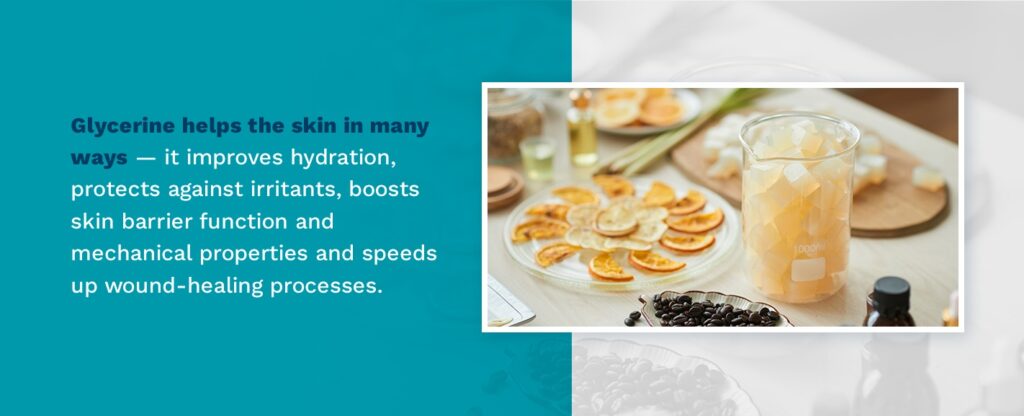
3. Ceramides
Ceramides are fat molecules, known as lipids, that help skin lock in moisture. They act as magnets to hold the skin cells together and form a protective barrier on the skin’s surface to holds in moisture and plump the skin. Ceramides also work to shield the skin from environmental factors, like dry air or pollution. Your skin naturally produces ceramides, but production drops as a result of aging, seasonal changes or the use of too many harsh soaps or exfoliants.
Dry skin is a clear sign your ceramide levels are lower than what they’re supposed to be. Low ceramide levels are linked to skin conditions, such as eczema. Luckily, you can get more ceramides from many skin care products that mimic the natural ceramides your body produces, even in plant-derived or synthetic forms. Consider applying your ceramide moisturizer as soon as you get out of the shower so your damp skin can absorb the moisture.
Best Skin Care Ingredients for Oily Skin
Everyone has sebum — a thick fluid made of wax esters, squalene, triglycerides, free fatty acids, cholesterol esters and free sterols. When you don’t have a lot of it, you might have dry skin. If your body produces a lot of sebum, you’re likely to have oily skin. Oily skin is one of the most frequently reported dermatologic concerns. While oil may be a shiny nuisance, it can also lead to pimples and acne.
Using blotting papers and not touching your face can minimize oil production. Incorporating ingredients into your skin care routine explicitly designed to fight oil can provide more significant long-term results. Some ingredients are better for oily skin than others.
1. Salicylic Acid
Salicylic acid is a type of beta-hydroxy acid (BHA) — the most commonly used BHA in cosmetics — and comes from willow bark. Beta hydroxy acids and alpha hydroxy acids (AHAs) both work to exfoliate the skin, but BHAs are known to be oil-soluble, meaning salicylic acid can easily travel through the lipid layers between skin cells and go into the skin deeper than AHAs, which are water-soluble. Salicylic acid works deep in the skin to reach the pores and unclog them.
Salicylic acid works best on oily, acne-prone skin. It acts to get rid of whiteheads and blackheads, reduces oil production and discoloration from old breakouts, exfoliates the skin, and acts as an anti-inflammatory to help heal irritated skin. It is also less irritating to the skin than AHAs.
Your skin may experience mild irritation or stinging when you start using salicylic acid, so start slow and use it moderately, every other day until you know your skin can handle it. Then, you can start using it daily.
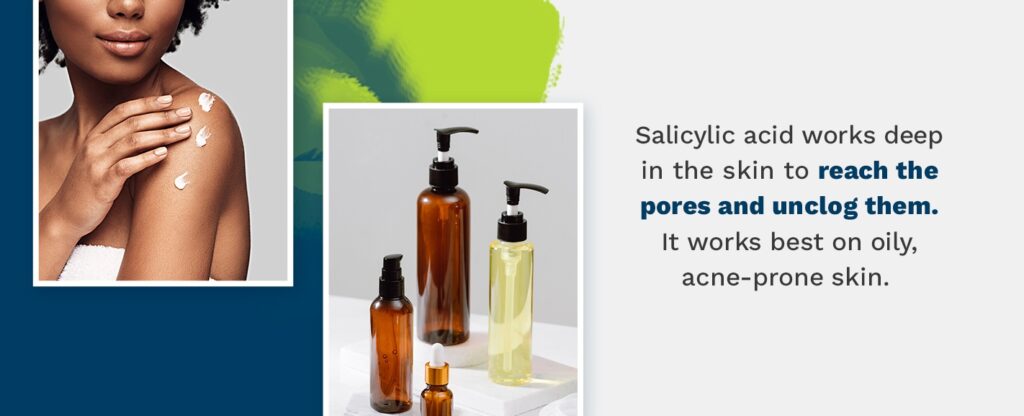
2. Castor Oil
Castor oil comes from the Ricinus communis plant. It is produced by cold-pressing castor seeds and applying heat. It has many different uses and continues to grow in popularity.
The ricinoleic acid in castor oil fights pore-clogging, acne-causing bacteria. Castor oil also has anti-inflammatory properties to help calm the skin and to provide moisturizing benefits.
3. Retinoids
Last but not least, many praise retinoids for their anti-wrinkle properties and for their acne-fighting properties. The retinoid family contains pure retinoic acid, the most potent form, vitamin A (retinol) and other retinol derivatives — the most gentle option out of the three. People have been using retinoids to treat acne since the 1970s, as retinoid use is connected to reduced pore size. As larger pores are connected to increased levels of sebum production, retinoids can help your skin reduce oil production and reduce acne.
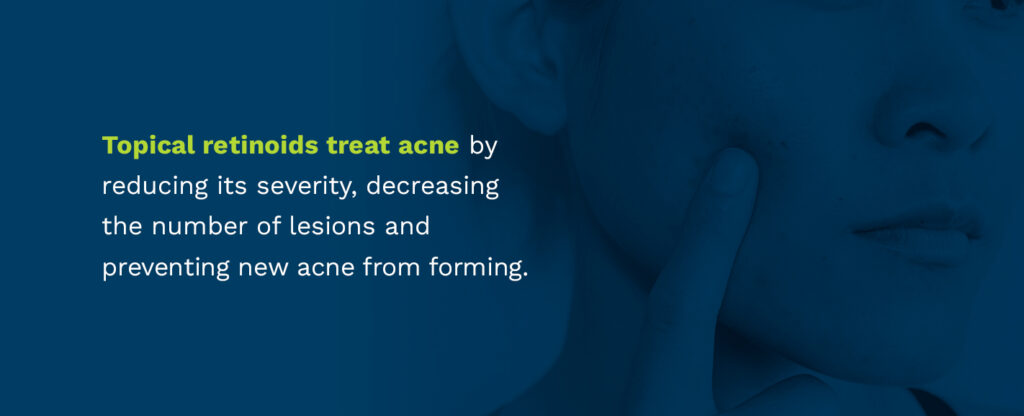
Topical retinoids treat acne by reducing its severity, decreasing the number of lesions and preventing new acne from forming. Additionally, they have even been found to improve and prevent atrophic acne scarring.
Retinoids vary in strength and you don’t need a high concentration level to see results. If you are incorporating a retinoid into your skin care routine for the first time, start with a low concentration and use it only once or twice a week. Based on how your skin reacts, you can gradually increase your use. You should also alternate retinoids with other products in your routine, such as salicylic acid, as using them at the same time may result in irritated skin.
Skin Care Ingredients for Normal Skin
Even though your skin is mostly normal, you probably still experience oil or dryness every once in a while. Look for skin care ingredients that can help you maintain a healthy complexion. Some skin care ingredients for normal skin to start incorporating into your routine include:
1. Vitamin C
Vitamin C is an antioxidant, that helps to keep skin cells healthy. Your skin contains high concentrations of vitamin C in the dermis and epidermis, but the concentrations decrease as you get older and as a result of exposure to the sun and pollutants.
The antioxidant speeds up collagen and elastin production to keep skin firm and plump. Vitamin C also fights aging by limiting damage from UV exposure, hydrating the skin and evening out skin tone and texture.
Many people use a vitamin C serum, worn under moisturizer. Vitamin C breaks down when it’s exposed to air or light, so the serums are packaged dark bottles to maintain the stability of the primary ingredient. Vitamin C is also known to be a potent ingredient, so it’s best to start with a lower concentration if you’ve never used it before — especially if you have sensitive skin.
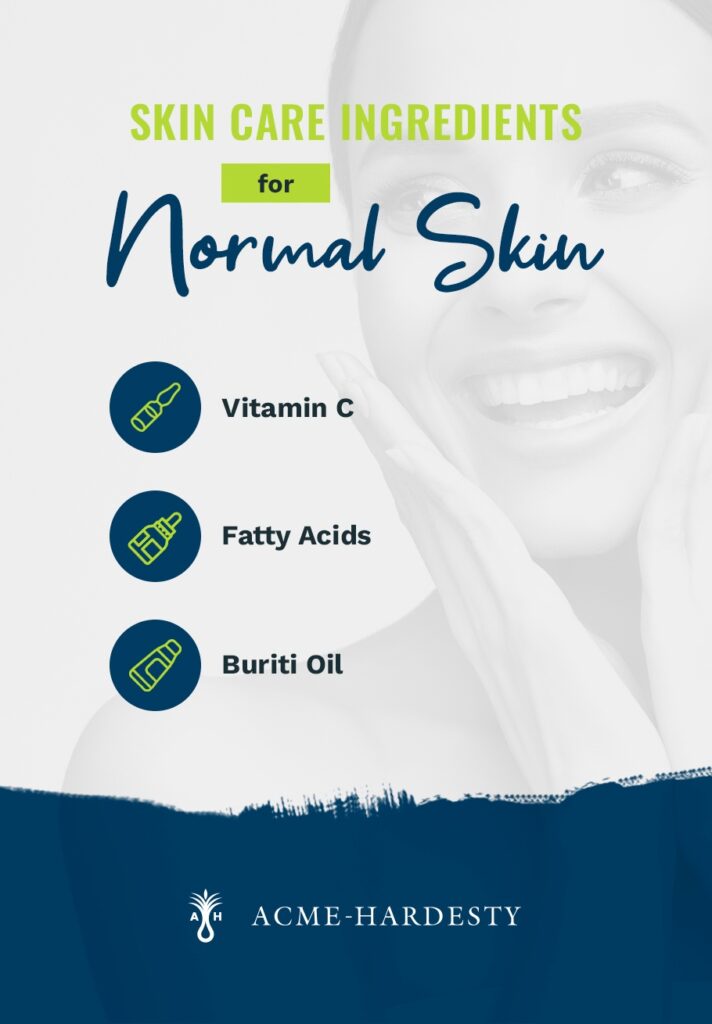
2. Fatty Acids
Fatty acids are skin care ingredient everyone needs. Fatty acids in your skin work to fight water loss and are anti-inflammatory and microbial. Some fatty acids that help the skin aren’t produced by your body, such as omega fatty acids. Using products with linoleic acid (omega-6), alpha linoleic acid (omega-3) and omega-9 (oleic acid) gives your skin numerous benefits.
Omega fatty acids help the skin increase its moisture and elasticity. The fatty acids also banish dry, flaky skin, soothe inflammation, protect against pollutants, reduce UV damage and regulate oil production. For example, studies show fish oil and other related omega-3 and omega-6 fatty acids can benefit the skin by improving barrier function, accelerate wound healing and prevent skin cancer development. They also hydrate dry skin caused by dermatitis and avoid inflammation and hyperpigmentation caused by UV rays.
3. Buriti Oil
Buriti oil comes from the fruit of the buriti palm. Because of its high beta-carotene content, buriti oil is a common ingredient in sun protection products, including pre- and post-sun applications. The beta-carotene in this oil helps reduce free-radical damage and photodamage, and other components, including fatty acids like oleic acid, deliver the same benefits as other skin care ingredients, such as improving skin’s elasticity.
Because of its benefits, buriti oil is a common ingredient in creams and lotions, soaps and products for oil baths, though it can be an effective stand-alone treatment in some applications. Products containing buriti oil are ideal for those with normal skin and aging concerns looking to fight fine lines, wrinkles and dark spots. Buriti oil can also provide benefits to the scalp and strengthen hair fibers, giving it more uses in skin care and beauty routines.
Skin Care Ingredients to Avoid
While many skin care products contain ingredients that help improve the look and condition of your skin, some also contain ingredients that are potentially irritating or even harmful. As you look for moisturizers, serums and other products to use in a skin care routine, keep an eye out for the following, which are best avoided.
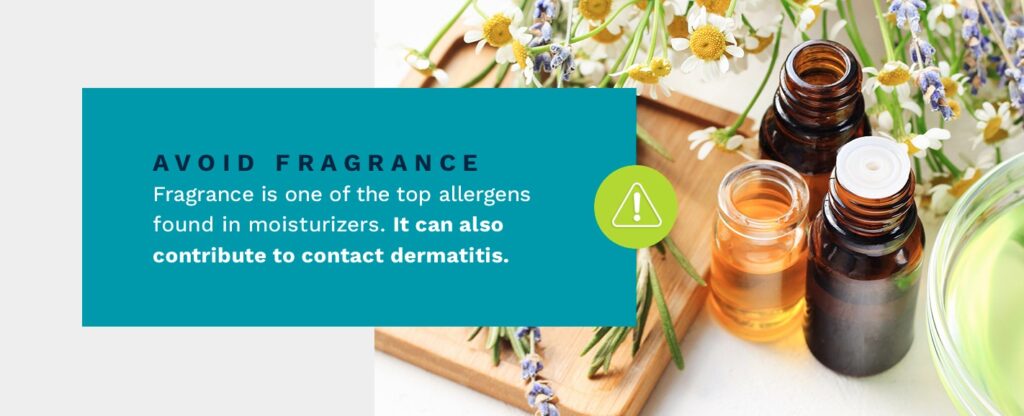
1. Fragrance
While fragrance can make your moisturizer smell good, it may also irritate your skin. Many cosmetic products, including skin care, include fragrances. Fragrance is one of the top allergens found in moisturizers. It can also contribute to contact dermatitis. Even if you don’t have ultra-sensitive skin, you may want to double-check that the items in your shopping basket are fragrance-free.
Fragrance-free products aren’t necessarily unscented. If you sniff a fragrance-free product but still smell something, you’re smelling the product’s natural scent.
2. Butylated Hydroxyanisole (BHA) and Butylated Hydroxytoluene (BHT)
Butylated hydroxyanisole (BHA) and butylated hydroxytoluene (BHT) are preservatives found in food and products like creams or sunscreens. BHA is a white-yellow waxy solid with a unique odor. It is considered to be a human carcinogen and has been found to have disrupting effects on the endocrine system. BHT is toluene-based, which has also been linked to health hazards. Your best bet is to avoid products with either BHT or BHA.
3. Formaldehyde
Formaldehyde or formaldehyde-releasing preservatives can keep bacteria from growing. When it’s broken down in water, it’s referred to as formalin — what is usually used as the cosmetic preservative.
What’s the problem with formaldehyde? It’s considered a human carcinogen. Additionally, cosmetics containing formaldehyde can lead to allergic reactions, such as contact dermatitis, and coughing, wheezing or nausea.
How to Start a Skin Care Routine You Can Stick With
Starting a skin care routine doesn’t have to be overwhelming. There are only three main steps to start with: cleansing, toning and moisturizing. You might add a fourth step and apply a separate sunscreen, or you can use a combination moisturizer/sunscreen.
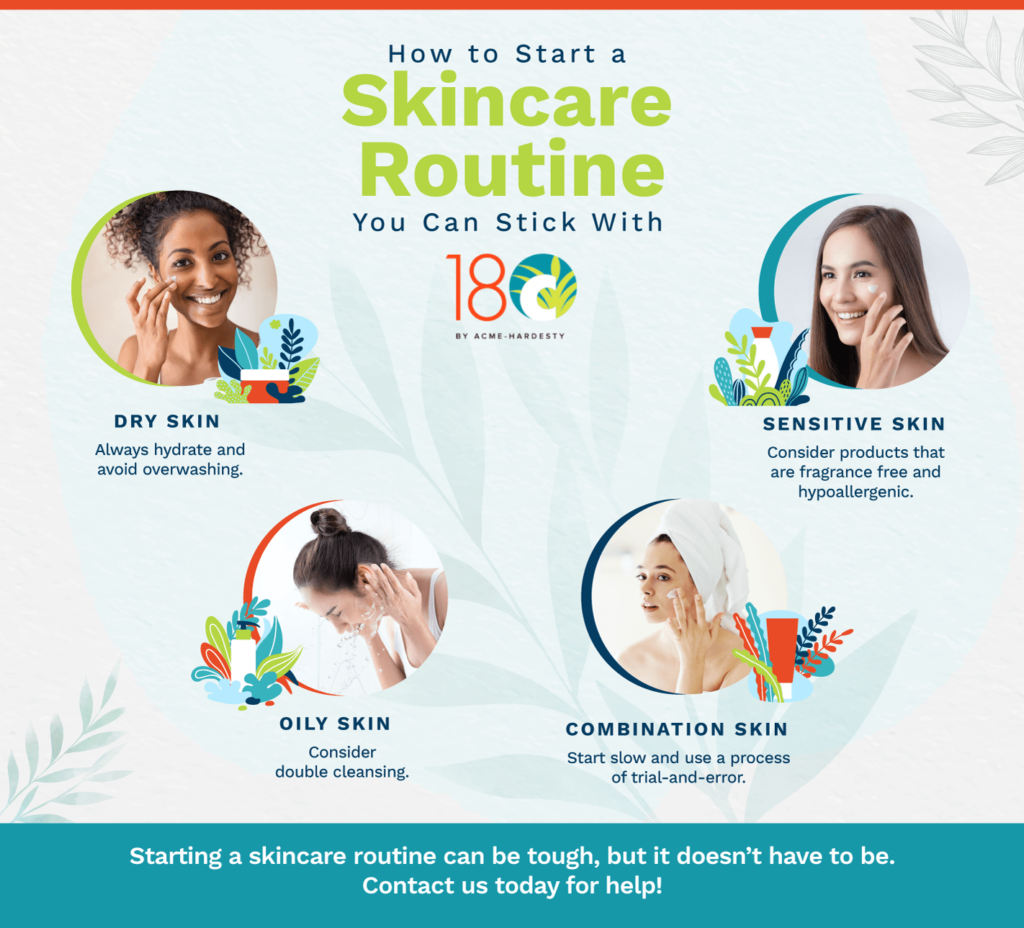
Skin care routines are highly personalized and catered to the needs of your skin. If you aren’t sure what skin type you have, think about your skin after you’ve been out of the shower for a few hours with no products or makeup on. If it gets shiny or greasy, you likely have oily skin. If it gets flaky or feels dry, you have dry skin. If you have some dry spots and some oily spots, you have combination skin, and if you have none of these things, you have what’s considered normal skin. If your skin is prone to irritation or allergic reactions, or if you have a preexisting skin condition such as eczema, psoriasis or rosacea, you likely have sensitive skin.
Follow these tips to start a routine you can keep up with, based on your skin type:
Dry Skin
If you have dry skin, you want to hydrate, hydrate, hydrate! Avoid overwashing your skin, which could end up drying it out even more. You don’t have to wash your face in the morning if you washed it before you went to bed.
Instead, you can start the day with an antioxidant serum, an eye balm and a moisturizer with an SPF of 30 or higher. Since you have dry skin, you can choose a moisturizer with a thick consistency. At the end of the day, use a cream or oil-based cleanser that doesn’t strip the skin of its natural oils and follow with an emollient night cream.
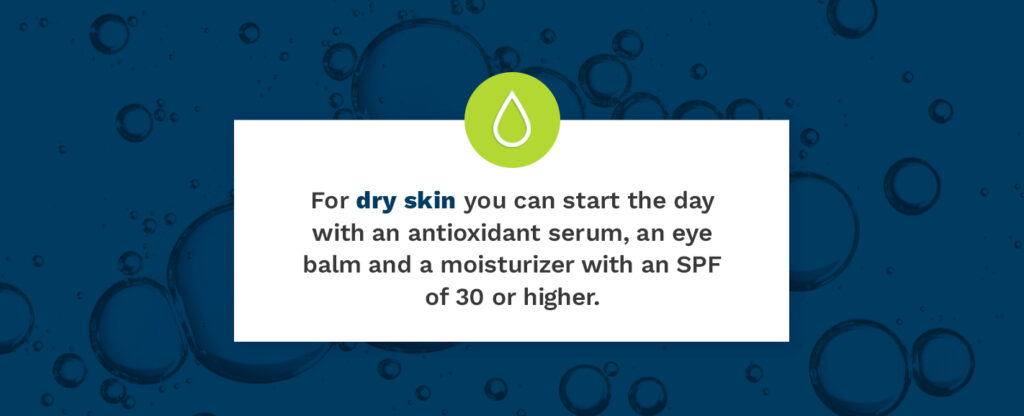
Oily Skin
If you have oily skin, consider double-cleansing. Double cleansing can help remove the makeup or dirt on your skin at the end of the day without leaving anything behind. To double-cleanse, start with an oil-based cleanser and follow up with a water-based cleanser or micellar water.
In the morning, you can use a foaming cleanser and follow up with a toner that has glycolic acid to help exfoliate your skin, while unclogging your pores and removing dirt. Toners are a great way to incorporate ingredients that may not otherwise be in your routine. You can apply them with a cotton pad. After toning, try an oil-free sunscreen in place of a moisturizer. At night, cleanse and tone your skin again and consider a retinoid night cream to keep oil under control.
Combination Skin
Finding the perfect balanced routine for combination skin can be a process of trial-and-error, so it might be best to start slow. If you have combination skin, start your morning with a cleanser that contains glycolic acid, an antioxidant serum, eye cream and moisturizer that contains SPF. In the evening, wash your face with a non-medicated cleanser and tone your skin. You should try a toner that’s recommended to use only once a day and then follow up with eye cream and an anti-aging serum or cream.
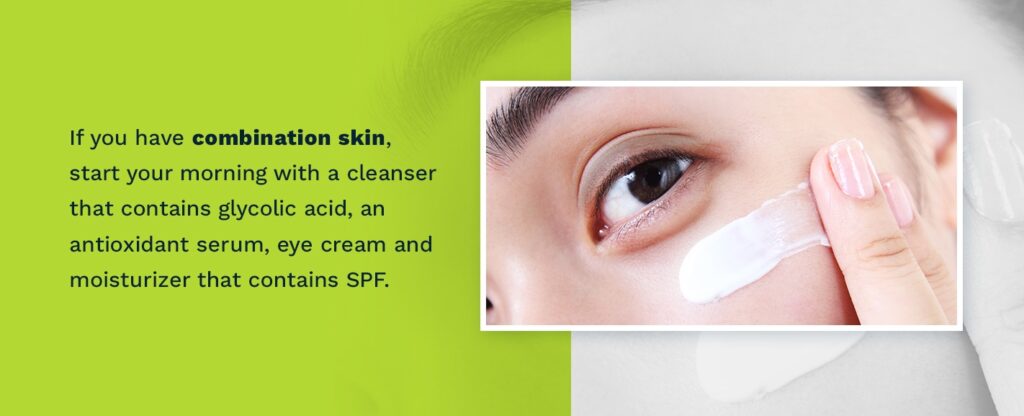
Normal Skin
If you have normal skin, you’re probably wondering if that means you can use whatever you want. As a general rule of thumb, stick to products that are gentle and work to nourish, hydrate and bring balance to your skin. Keep things simple.
You have the freedom to test products you want to try, but don’t try too many at once. Stick with a few staples and keep your routine persistent — results take time. You should try to use a product consistently for at least six weeks, once or twice a day to see a difference.
Sensitive Skin
Establishing a daily skin care routine for sensitive skin requires extra care. Gentle products that won’t irritate your skin are crucial, so choose fragrance-free, hypoallergic products. In the morning, try a cleanser with benzoyl peroxide and follow with a toner, eye cream and SPF moisturizer. Cleanse again in the evening and tone, and then moisturize as a final step.
A balm moisturizer may be an excellent option for those with sensitive skin. Additionally, sensitive skin can also be oily, dry, combination or normal, so you can adjust some products accordingly as long as you are extra cautious and only choose products that won’t irritate your skin.
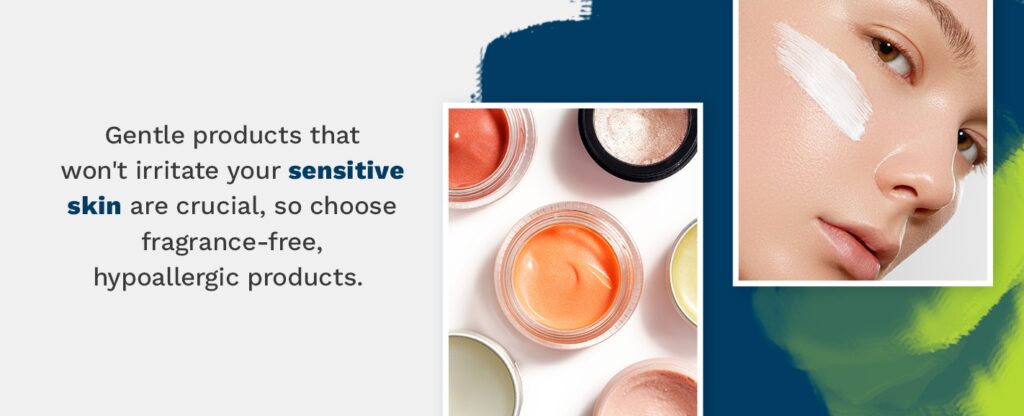
Contact Acme-Hardesty for Your Must-Have Natural Skin Care Ingredients
No matter if you have normal, dry, oily, combination or sensitive skin, a solid skincare routine can do wonders for your skin’s health and even your mental wellbeing. If you’re looking to incorporate a skincare routine into your day, Acme-Hardesty supplies the natural skin care ingredients that your skin will thank you for it. As one of the largest distributors of castor oils and derivatives, glycerine and fatty acids, we can guide you to happy, healthy skin as experts in the personal care industry. Get started by choosing your market or contact us today.
